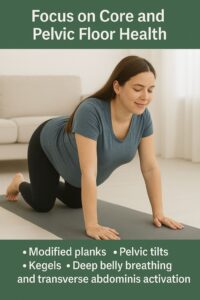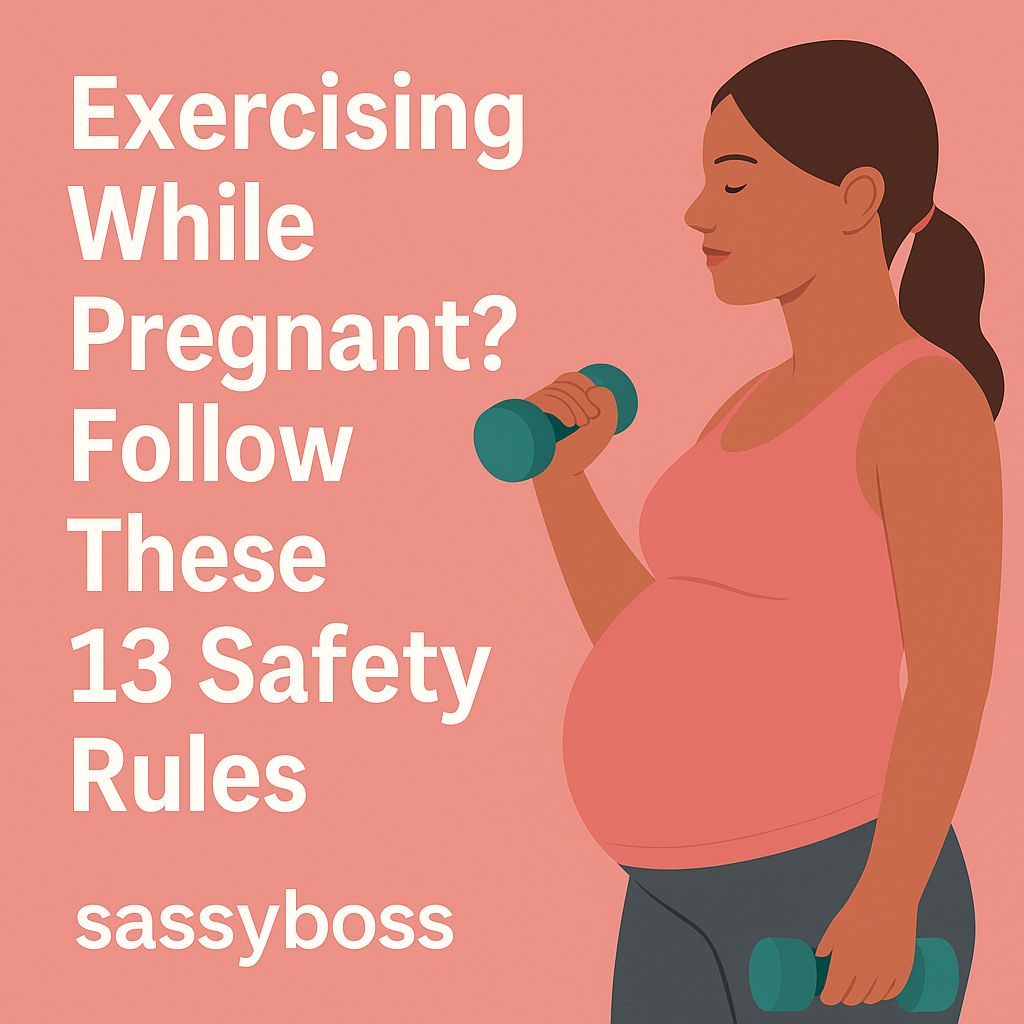Exercising While Pregnant? Follow These 13 Safety Rules
Although pregnancy is a wonderful and life-changing experience, it can also be very demanding, particularly when it comes to maintaining an active lifestyle. The good news is that, in the majority of situations, exercising while pregnant is safe. Frequent exercise can help you sleep better, reduce stress, straighten your posture, and possibly make birth and recovery easier for you and your unborn child.
But working out during pregnancy isn’t the same as working out before getting pregnant. Every day, your body changes, therefore it’s critical to adapt your exercise regimen to meet your shifting needs. At that point, safety becomes very important.
Here are 13 safety rules to follow to ensure your workouts are both effective and pregnancy-friendly.
1. Always Get Medical Clearance First

Consult your healthcare provider before putting on your footwear. Each pregnancy is different. Exercise is healthy for the majority of women with low-risk pregnancies, but some circumstances, such as placenta previa, preeclampsia, or a history of premature birth, may call for extra care or limitations.
Tip: Throughout your pregnancy, be sure to keep your provider informed of any new symptoms or discomforts.
2. Listen to Your Body
This rule is straightforward yet essential: stop if anything doesn’t feel right. It is not appropriate to endure discomfort, exhaustion, or dyspnea during pregnancy. Follow your gut and take pauses as necessary.
Dizziness, chest pain, vaginal bleeding, contractions, or fluid leaking are warning signs. Consult your physician and cease exercising right once if you encounter any of these symptoms.
3. Stay Hydrated
Your fluid requirements rise during pregnancy, particularly if you’re active. Overheating and even early contractions might result from dehydration.
What to do: Prior to, during, and following your workouts, sip water. Even if you don’t feel thirsty, have a water bottle with you and take frequent sips.

4. Avoid Overheating
During pregnancy, your core body temperature normally rises, and exercise can cause it to climb even further. Your developing baby may suffer from overheating, particularly during the first trimester.
How to prevent it:
• Avoid hot and humid environments.
• Wear breathable, moisture-wicking clothing.
• Opt for early morning or evening workouts when it’s cooler.
• Choose indoor activities with proper ventilation or air conditioning.
5. Modify Your Workouts as You Progress
Your body changes dramatically across all three trimesters. What feels easy in the first trimester might be challenging in the third.
Adaptations to consider:
• In the second and third trimesters, avoid exercises that require lying flat on your back for extended periods. This position can restrict blood flow to the baby.
• As your balance changes, skip activities that require sudden direction changes or quick footwork.
• Consider lower-impact versions of your favorite workouts—like switching from jogging to brisk walking or from HIIT to prenatal yoga.

6. Focus on Core and Pelvic Floor Health
During pregnancy, labor, and the postpartum period, your pelvic floor and core are essential. In addition to improving posture and lowering back discomfort, strengthening these areas can help avoid incontinence and diastasis recti, or abdominal separation.
Best exercises:
• Modified planks
• Pelvic tilts
• Kegels
• Deep belly breathing and transverse abdominis activation
Avoid full sit-ups, crunches, or movements that cause your belly to bulge or “dome.”
7. Keep Your Intensity Moderate
Generally speaking, you should be able to converse while working out. Turn it down if you’re having trouble breathing or feel exhausted.
Use the Rate of Perceived Exertion (RPE) scale: Aim for a 5–7 out of 10, where 10 is your maximum effort.
8. Warm Up and Cool Down
During pregnancy, it’s more crucial than ever to perform the warm-up and cool-down. While cooling down gradually returns your pulse rate to normal, a decent warm-up prepares your muscles and joints.
What to do:
• 5–10 minutes of light cardio (walking or slow pedaling)
• Gentle dynamic stretches before your workout
• Static stretches and breathing exercises afterward
9. Avoid High-Risk and Contact Sports

Some sports pose too high a risk of falling or trauma to your belly.
Avoid activities like:
• Skiing
• Horseback riding
• Contact sports (like soccer or basketball)
• Scuba diving
• Hot yoga or hot Pilates
Stick with safer alternatives like walking, swimming, stationary biking, prenatal yoga, and strength training.
10. Maintain Good Posture and Form
As your belly expands, your center of gravity changes, which can impact your balance and posture. You run a higher risk of strain and injury if you have poor form.
Tips for better posture:
• Keep your spine neutral (no over-arching your back)
• Engage your core lightly during movement
• Use mirrors or a trainer to check your form
• Avoid locking your joints or hyperextending limbs
11. Eat Enough to Fuel Your Body

Your energy needs rise as you exercise. It’s obvious that you shouldn’t exercise on an empty stomach when you take into account the nutritional requirements of pregnancy.
What to do:
• Have a light snack 30–60 minutes before working out (e.g., banana, yogurt, toast)
• Eat a balanced meal afterward to help with recovery
Don’t use exercise as a way to restrict calories—your goal is to nourish, not deplete.
12. Choose the Right Footwear and Support Gear

The hormone relaxing causes your ligaments and joints to become more flexible, increasing your risk of injury. Support and appropriate footwear can have a significant impact.
What to wear:
• Supportive sneakers with good arch support
• A high-quality maternity sports bra
• A belly band (especially helpful in the third trimester for added abdominal and back support)
13. Be Kind to Yourself
It’s acceptable if all you can do on some days is take a stroll around the neighborhood. Personal bests and aesthetic objectives are not appropriate during pregnancy. It’s a moment to pay attention, move with awareness, and respect your body’s requirements.
Remember: Rest is just as important as movement. Don’t feel guilty for scaling back or skipping workouts when you need to.
Final Thoughts
Pregnancy-related exercise has amazing advantages, ranging from enhanced mood and sleep to increased labor stamina. However, it needs to be done safely. The purpose of these 13 commandments is empowerment, not restriction. You can continue to have an active, healthy lifestyle during your pregnancy with careful planning and advice from your doctor.
Whether you’re performing yoga during pregnancy, lifting small weights, or just going for a daily stroll, keep in mind that you’re doing something incredible for both you and your unborn child.
